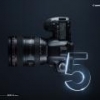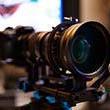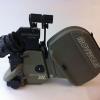
Policar
-
Posts
406 -
Joined
-
Last visited
Reputation Activity
-
 Policar got a reaction from Tim Fraser in Tempted? Should you get a $6499 Canon C300 or wait until after NAB?
Policar got a reaction from Tim Fraser in Tempted? Should you get a $6499 Canon C300 or wait until after NAB?
The CX00 line has the best image rendering available short of the Alexa (worse highlight rendering than the Dragon, but much better noise pattern and low light and color) and this is a STEAL. But the C300 Mark II has some features that are really disruptive (and oddly forward-thinking) so investing now might not be the best choice, especially among the IQ-centric audience that populates enthusiast sites.
Canon (and Arri) are after the "pro" market. Which is all about "good enough" out of the box, because when you're "pro" you get paid and so hiring a crew and post team costs money. The focus isn't image quality. A low bitrate is desirable, as is an image that doesn't need (or have) much flexibility for grading... It's decent 1080p that has small file sizes in an easy-to-ingest format that attract the pros. Not because they're better or more talented (clearly they aren't judging by the quality of reality tv) but because they care about money first and a camera with small file sizes, amazing ergonomics, and a great image out of the box gets you the most for you money. For enthusiasts who enjoy grading and 4k and want the best IQ (if you like raw, don't get Canon–I can't stand raw because it wastes my time, so I love Canon)... go with something that's more techie and more fun. For wedding videographers and professional shooters on the low end, get what your clients prefer (Canon or Alexa more toward the high end).
That said, I like to judge images based on images and not specs. Canon's 1080p is sharper than anyone else's (not sharper than others' 4k, though, but 99% of the world is delivering to 1080p) and their colors are better than anyone other than maybe Arri. Sony's images have been garbage until SLOG 3 started to fix saturation clamping and color matrices but it's still nowhere near Canon level. Dragon Color is quite good, however, on the Red side. But the saturation clamping, skin tones, etc from Canon... brilliant. WideDR is a fantastic color space and Canon Log is sort of functional for what it is.
The C300 isn't an enthusiast product, it's for pros (who care about money they can make back over image quality and about ergonomics; this is why the 1DX is 18MP to the enthusiast's 5DSR's 50+ MP but the 1DX has killer AF and durability) and so it is hard to recommend Canon to most people on this forum.
Especially when the C300 Mark II outclasses the Alexa. But it won't come cheap.
-
 Policar got a reaction from Ed_David in Red Weapon Top of Food Chain???
Policar got a reaction from Ed_David in Red Weapon Top of Food Chain???
There are dimensions other than resolution to be explored. The C300 will be viable for delivery to 95% of clients for a very very long time, but when it becomes dated, it won't be because of its lack of resolution. The 1080p out of that thing looks sharper than the Alexa's 2.8k, which is already sharper than 35mm film, which is already sharp enough. Of course the ability to reframe that 4k provides is pretty nice.
2k is already sharper than the human eye can see on any tv screen less than 80" (at normal viewing distances) and any seat not in the first third of a theater. There's a reason the leap from SD to HD was huge but not from HD to 4k except when you look closely at the screen as you do with an iPhone or laptop. We've already gone about as far as we can go toward matching the human eye's spatial resolution. Retina screens caught on because of how close you hold them but for theatrical exhibition and televisions, 2k is good enough. Completely. Not for IMAX or whatever, though, or for massive home projectors or 80''+ tvs. There's a market for which 4k matters, it's just not big. Ironically, if it catches on anywhere it will be on computers phones. Small screens held close. Not big.
Spatially, the eye can see about 60fps before it all blurs together and everything looks equally smooth. 24fps has caught on aesthetically, but slow motion is quite popular and HFR may catch on after Avatar 2. This is a dimension that might be explored further and that the C300, for instance, can't really push far into.
We can see gobs more DR than any camera or tv currently produces or captures. This is somewhere more worthy of exploration than the jump from HD to 4k.
FF/Vistavision isn't just great for using cheap vintage still lenses and cheap still lenses in general. It also provides a large enough sensor to shoot proper anamorphic, something currently only the higher-specced Alexas and A7S can do properly.
rec709 is a very tiny gamut. This is another dimension that is worthy of being expanded upon. rec2020 is coming.
Low light will just improve more and more. Skew decrease more and more.
There are much more exciting things than the jump from 1080p to 4k on the horizon. And closer than most realize...
Again, I'm just saying if your finger is hovering over that F5 or FS7 buy button and you don't need it for a project in the next month...
...hold off a little longer. It's worth it.
-
 Policar got a reaction from mtheory in Alexa Mini!
Policar got a reaction from mtheory in Alexa Mini!
No visible difference between ProRes and RAW on anything other than IMAX good. Even then, 99% of people wouldn't catch a thing. ProRes from the Alexa is flawless, better than Red Raw at high bitrates. Who knows why.
You can't change your ISO (digital gain) in prores, but in my experience Alexa footage grades much more flexibly than any Red footage and the log implementation is so far superior to Sony's and Canon's... you just move your gamma slider and it feels like you're moving your exposure.
The Alexa is the real deal.
-
 Policar got a reaction from Axel in Moire Removal / Lessening
Policar got a reaction from Axel in Moire Removal / Lessening
They're dirt cheap. Though film isn't, but you can buy short ends. SR3s are selling for peanuts now and the images look as good as ever.
I just do this for fun (and the occasional paycheck), so it's still a little too expensive for me.
If you've never tried a Bolex, even that is a lot of fun. Just the lab fees and scans are brutal.
-
 Policar got a reaction from Nick Hughes in Moire Removal / Lessening
Policar got a reaction from Nick Hughes in Moire Removal / Lessening
1) Certainly good advice, but not always possible. I agree, though, that's the best approach. I've even seen the Alexa alias pretty severely in the right circumstances (fine-pattererned red fabrics at certain distances), and beta cam did terribly. Being smart when addressing set design is always a good choice.
2) Uhh... sure.
3) No. CCDs alias just as much as CMOS sensors... it's what's in front of the sensor and how it's processed that matters.
4) Worth a try, so is pushing the image just slightly out of focus if you really need to. If it's a brick wall in the distance, you won't lose that much resolution throwing it just a little out of focus to lessen aliasing. But kind of iffy.
5) The human eye does not see any more moire than you put in front of it. If you put an image of something that has moire in front of it, it will see it, same as with film, which also doesn't otherwise alias.
I've had really, really good luck with some post techniques, assuming the aliasing isn't horrible. I sample the aliasing in Neat Video and use a 0-radius temporal filter and extremely strong low frequency noise reduction settings. Then I mask this in After Effects where needed, maybe add a little blur, then regain. For less severe (color only) aliasing you can copy the footage onto a layer above the original shot, add a 12-pixel radius blur (or thereabouts) and superimpose that blurred footage using the color transfer mode. I also mask this layer as it fuzzes out the richness of the color. These techniques are a pain, but very effective at at least reducing aliasing.
That said, the fabric thing is your best bet. Although I'd had decent luck tackling fabric in post, only if it's pretty minor in the first place though. So shoot smart... choose appropriate fabrics for your camera (as I said above, Alexa aliases with some red fabrics, and the Canon C series even more so, despite both being pretty alias-free normally), throw your worst aliasing out of focus or avoid shooting brick walls in establishing shots (or shoot a still and blur it and composite it in later: seriously).
Suddenly I don't miss my t2i as much.
-
 Policar got a reaction from Axel in Cheap color correction monitor
Policar got a reaction from Axel in Cheap color correction monitor
I've been using the new Dreamcolor, which is ok except that it has bad off-axis performance (really more an issue with a weird anti-reflective coating), poor uniformity for a reference monitor, and it's only an 8 bit panel. I feed it with a black magic interface (via HDMI) and can grade off my rMBP with no problem. It's a pretty nice set up. Calibrated to rec709 out of the box, but need recalibration after a while.
For a little more (or a lot more, really), the FSI BM210 is sick. Also an 8 bit panel, but amazing.
There are some inexpensive (older) plasma and LCD tvs that you can get really close with simple blue gel and pluge bars. If you're grading for broadcast and aren't a perfectionist and know how to follow your scopes.
Fwiw, 709 and sRGB have about the same chromaticities (or trivially far apart), but different gamma. Are you grading for web or for broadcast? If for web any decent calibrated display will do fine. I like the dell ultrasharp line and you can get a nice $200 dell and $150 probe and be all good. For broadcast, the Dreamcolor isn't really "good enough," but it kind of actually is. There are good LCD and Plasma tvs out there, too, but the blacks often take on tints that aren't trustworthy and I find the skin tones sometimes skew a bit magenta or yellow and the greens a bit teal or chartreuse. Unfortunately, those are very important colors. But you can still get 98% great.
It's difficult to tell anything from the video you posted. What are your IRE values on the noise floor? If you want to know if it's crushed or not that is where you will find out definitively.
-
 Policar got a reaction from nahua in So what's the point?
Policar got a reaction from nahua in So what's the point?
It's more an aesthetic choice than anything. While you can fake the look (poorly) using string and an oval aperture cut-out, the flares, distortion, and character of the image don't really look the same. Then again, eBay adapters don't really look like Panavision anamorphic lenses, either.
But it's always been an aesthetic choice (at last in recent history). Look at how much was shot in 2.35:1 two perf as an alternative to anamorphic in the 90s and oughts. Michael Bay is an interesting example... shot Bad Boys II in 2.35:1 spherical then moved to anamorphic exclusively until he switched to shooting on both digital and film. Some DPs don't like the unnatural look of anamorphic lenses (Roger Deakins never uses them, while he does shoot 2.35:1 at times); some directors just like the nostalgia (JJ Abrams). There's a bit more resolution, sure, and a finer grain structure on film, but it's primarily an esthetic choice, rather than a technical one, and has been for decades.
When digital became popular, it was difficult to shoot anamorphic because of the 16:9 sensor size resulting in a 3.5:1 image, so shooting anamorphic became rarer on digital formats and perceived as more "high end." Every element of anamorphic has a totally different look, from the bokeh, to the distortion, to the flares, and some directors (Anthony Mandler) even embraced the 3.5:1 look. Meanwhile only the Alexa Plus has a 4:3 sensor so between renting that and anamorphic lenses you're spending a lot of money. So it's a way to make your production look high end... check out the new Total Recall (Epic) and Ninja Turtles movies to see digital anamorphic photography on high end CGI-filled features. Check out the Lego Movie (or, Wall•E) to see an anamorphic look on pure CGI... total aesthetic choice here, but it makes it look more "real" and more high end. The weird lens artifacts take off a bit of digital sterility.
On the ultra low end hobbyist side, the Iscorama (still hoping to buy one) seems particularly nice because it gives you 2.6:1 and lets you focus and use a variety of lenses, but we'd all rather be using an Alexa Plus and Panavision lenses in theory. But anamorphic could give you the right look for the right project. If I'm doing a Spielberg 80s homage like Super 8 or something I'd much rather be shooting anamorphic. If a director wants it you should be able to provide it. If you're the director and you don't care, yeah, pass. I think the 1.33:1 adapters seem odd.
Treat it as an aesthetic choice, not a technical one. Ultimately, every choice is.
Fwiw, a lot of anamorphics are decently sharp at t2.8. And sharp isn't always the goal. 1080p is enough resolution to let you focus on texture and grain, not just crispness. If you watch the Dark Knight blu ray (not my favorite movie, but whatever) you can see that the IMAX portions are way sharper than the anamorphic portions even at 1080p! But the anamorphic photography has a good look. Very organic. Those are some nice looking movies. Kaminski doesn't shoot anamorphic (at least not much that I know of) but he softens and distorts the image in a really organic way through other means while still getting a sharp enough image for projection and blu ray.
-
 Policar got a reaction from robbing in So what's the point?
Policar got a reaction from robbing in So what's the point?
It's more an aesthetic choice than anything. While you can fake the look (poorly) using string and an oval aperture cut-out, the flares, distortion, and character of the image don't really look the same. Then again, eBay adapters don't really look like Panavision anamorphic lenses, either.
But it's always been an aesthetic choice (at last in recent history). Look at how much was shot in 2.35:1 two perf as an alternative to anamorphic in the 90s and oughts. Michael Bay is an interesting example... shot Bad Boys II in 2.35:1 spherical then moved to anamorphic exclusively until he switched to shooting on both digital and film. Some DPs don't like the unnatural look of anamorphic lenses (Roger Deakins never uses them, while he does shoot 2.35:1 at times); some directors just like the nostalgia (JJ Abrams). There's a bit more resolution, sure, and a finer grain structure on film, but it's primarily an esthetic choice, rather than a technical one, and has been for decades.
When digital became popular, it was difficult to shoot anamorphic because of the 16:9 sensor size resulting in a 3.5:1 image, so shooting anamorphic became rarer on digital formats and perceived as more "high end." Every element of anamorphic has a totally different look, from the bokeh, to the distortion, to the flares, and some directors (Anthony Mandler) even embraced the 3.5:1 look. Meanwhile only the Alexa Plus has a 4:3 sensor so between renting that and anamorphic lenses you're spending a lot of money. So it's a way to make your production look high end... check out the new Total Recall (Epic) and Ninja Turtles movies to see digital anamorphic photography on high end CGI-filled features. Check out the Lego Movie (or, Wall•E) to see an anamorphic look on pure CGI... total aesthetic choice here, but it makes it look more "real" and more high end. The weird lens artifacts take off a bit of digital sterility.
On the ultra low end hobbyist side, the Iscorama (still hoping to buy one) seems particularly nice because it gives you 2.6:1 and lets you focus and use a variety of lenses, but we'd all rather be using an Alexa Plus and Panavision lenses in theory. But anamorphic could give you the right look for the right project. If I'm doing a Spielberg 80s homage like Super 8 or something I'd much rather be shooting anamorphic. If a director wants it you should be able to provide it. If you're the director and you don't care, yeah, pass. I think the 1.33:1 adapters seem odd.
Treat it as an aesthetic choice, not a technical one. Ultimately, every choice is.
Fwiw, a lot of anamorphics are decently sharp at t2.8. And sharp isn't always the goal. 1080p is enough resolution to let you focus on texture and grain, not just crispness. If you watch the Dark Knight blu ray (not my favorite movie, but whatever) you can see that the IMAX portions are way sharper than the anamorphic portions even at 1080p! But the anamorphic photography has a good look. Very organic. Those are some nice looking movies. Kaminski doesn't shoot anamorphic (at least not much that I know of) but he softens and distorts the image in a really organic way through other means while still getting a sharp enough image for projection and blu ray.
-
 Policar got a reaction from jcs in Canon 1D C used price slips under £5000 - and why I decided to take the gamble and get one
Policar got a reaction from jcs in Canon 1D C used price slips under £5000 - and why I decided to take the gamble and get one
On the contrary, the C500 and 1DC are the best-specced cameras Canon offers, and the least successful.
For a "professional" workflow, the smallest file sizes win out over 6k and such. Major network shows shot on the Alexa go with prores 422 hq than 444 because the savings in storage trump the extra image quality!
For enthusiasts the Panasonic and Sony cameras are fine, but they do make compromises. The 1DC seems like a good deal now if you're a dSLR-style shooter. Canon dSLRs still have the best color.
-
 Policar reacted to Andrew Reid in Canon 1D C used price slips under £5000 - and why I decided to take the gamble and get one
Policar reacted to Andrew Reid in Canon 1D C used price slips under £5000 - and why I decided to take the gamble and get one
From my cold dead hands
-
 Policar got a reaction from someguy in Canon interview at Photokina 2014 - 7D Mark II - Magic Lantern - and moire
Policar got a reaction from someguy in Canon interview at Photokina 2014 - 7D Mark II - Magic Lantern - and moire
Exactly. Canon will improve their video a bit now that Nikon is improving their video (Nikon is currently their only real competitor in the pro dSLR market), but it won't be much or terribly soon. I do think the lack of moire in the Mark III was a real attempt to improve video and I see the Mark III used for professional BTS and corporate video ALL the time, even with some very very high end clients.
What's funny is that Canon has crippled its products in pretty obnoxious and obvious ways... but no one here seems to care about their legitimately obnoxious omissions. On the still side leaving out 1/3 stop increments and MFA is a big deal and unnecessary. For video it's worse: AVCHD instead of XF Cam on the C100 is a significant and unnecessary downgrade, the lack of 60/720p confusing, but much, much worse is the lack of HDSDI/timecode and the horrible viewfinder...
Next to those omissions, a lack of 4k is basically irrelevant.
VERY few clients want a 4k finish. A LOT want timecode sync for dual sound. A LOT want a codec that's 50Mbps or higher. The viewfinder thing is just dumb beyond words. I mean that viewfinder is awful.
But that's what Canon is about. dSLRs marketed toward still photographers and a cinema line marketed toward low/mid end professional video production. And from what I've seen they have 95% marketshare among pros in those categories. I do see a lot of Red Scarlets and Alexas, but the Scarlets don't rent nearly as well as C300s and the Alexas are too expensive. Sony has some traction, too, but Canon did amazingly well with the C300.
Among artists? Well, you're the client. Buy what you want!
-
 Policar reacted to bertzie in Canon interview at Photokina 2014 - 7D Mark II - Magic Lantern - and moire
Policar reacted to bertzie in Canon interview at Photokina 2014 - 7D Mark II - Magic Lantern - and moire
The Vixia is a video camera. The 7dmk2 is a stills camera.
Would you complain that a geo metro doesn't come with a fifth wheel hitch?
-
 Policar got a reaction from Roma Tataru in A more realistic impression of the Sony A7S low light performance at ISO 12,800
Policar got a reaction from Roma Tataru in A more realistic impression of the Sony A7S low light performance at ISO 12,800
The C100 should have a slightly different noise texture, but it shouldn't be a different color temperature and exposure at apparently equal settings so right off the bat it's obvious that whoever did this is doing something wrong.
When you're examining low light performance by testing ISO, you need to stop down or change the shutter speed to compensate. If you expose everything much too brightly it gives an unrepresentative result...
In the test posted, they're boosting the ISO, but not stopping down or decreasing light levels to keep the exposure consistent. So the image won't look noisier… just brighter. The test is totally useless for this reason. If I point a C300 at a light bulb at ISO 80,000 of course it will be noiseless, it will be pure white… and it's that but a little less egregious. To compare ISO meaningfully you need to compensate and shoot at an even exposure, by stopping down, adjusting shutter speed, adjusting light levels etc… Look at virtually every other ISO comparison ever made.
This "test" is just… incredibly stupid and whoever performed it doesn't have a basic grasp of exposure. Not trying to be rude, but if you don't know what you're doing you might use this as a reference, and it's useless as one. The C300 is only this clean at extreme ISOs when extremely overexposed and, likewise, only noisy at low ISOs when underexposed. A series of shots exposed at key at different ISOs would have been useful, and that is how every other worthwhile ISO test I've seen has been handled. (I've seen this mistake repeated, but it doesn't make this any better or more useful.)
-
 Policar got a reaction from Aussie Ash in Sony A7S - 4K sample video
Policar got a reaction from Aussie Ash in Sony A7S - 4K sample video
Looks amazing if it lives up to the hype and comes in at that price. Low ISO looks on par with CX00, but should be even better in theory.... FF compatible with EF-mount lenses... wow.
SLOG 2 is a big deal if it is on par with the F5. Sony F3 began with very poor footage, low DR, SLOG pushed it up to 12+ stops... F5 reaches an easy 13+ stops of DR in SLOG 2. Given that the Epic manages 12 and just barely... that's a big deal if this can deliver. (Most Canon dSLRs in cinestyle come in around 9-10 stops with poor tonality, imo.) SLOG 2 underexposes then pushes... means muddy shadows and lower end mids (it's not Log C by any means) but if it is on par with what the F5 does then that that separates this from every other dSLR-type camera other than the 1DC and puts it in production camera territory, which the codec seems built for, too. Promise of gobs of highlight detail missing from everything else and a codec/gamma curve that's built to intercut with whatever.
I'm sure the images in stills and video far outstrip my C100 and 5d Mark III but Canon's shoddy products always lure me in over Sony/Black Magic/Red/Panasonic/everyone else's glorious tech demos. This looks amazing for the price, though, and highly useable.
-
 Policar got a reaction from mtheory in RED cameras absent from all Oscar cinematography and best picture nominees
Policar got a reaction from mtheory in RED cameras absent from all Oscar cinematography and best picture nominees
Then:
Explain to him how he's wrong about the ugly noise texture in all MX footage, especially tungsten-balanced, making the image look cheap and chunky and digital.
Explain to him why the shadows get so chunky and blue in any tungsten-balanced Red scene, whereas Alexas can be shot under any lighting condition. And then go on and add why the Alexa's superior low light ability is irrelevant.
Explain to him why it's irrelevant that the Alexa has a smoother noise texture, much more like film.
Explain to him why, despite the Red's 13.5 stops of DR being is a total lie (in fact the camera has no more DR than the C300, less than the F5, and a magenta-tinted highlight rolloff), it's still better than the 14.5+ stops smoothly handled in the Alexa.
Explain why the Alexa's superior midrange tonality isn't significant.
Explain why red code botching details in skin and foliage (again, some of the most emotionally resonant subject matter...) is irrelevant, whereas ArriRAW is fine and even prores handles these details well.
Explain to him why the color science of the Alexa matches 5219 almost exactly and offers smooth creamy flesh tones and beautiful green foliage, whereas the red totally botches memory colors, but that's ok.
Explain to him how he's wrong that the OLPF of the Red offers ugly internal reflections and color cast over highlights, whereas the Alexa rolls off smoothly like film.
I'm curious. Explain how an ugly image with good specs looks better than a beautiful one with somewhat lesser specs.
Personally I would shoot a C300 or F5 over an Epic; the Epic has a stranglehold on summer blockbusters for the resolution advantage, but the look is just so... ugly and the workflow so damn shitty.
Yes there is beautiful content shot on red. But Prometheus, for instance, required a lot of CGI lipstick to dress up that pig.
I do find the character of the Monochrome sensor to be superior.
-
 Policar got a reaction from odie in RED cameras absent from all Oscar cinematography and best picture nominees
Policar got a reaction from odie in RED cameras absent from all Oscar cinematography and best picture nominees
Then:
Explain to him how he's wrong about the ugly noise texture in all MX footage, especially tungsten-balanced, making the image look cheap and chunky and digital.
Explain to him why the shadows get so chunky and blue in any tungsten-balanced Red scene, whereas Alexas can be shot under any lighting condition. And then go on and add why the Alexa's superior low light ability is irrelevant.
Explain to him why it's irrelevant that the Alexa has a smoother noise texture, much more like film.
Explain to him why, despite the Red's 13.5 stops of DR being is a total lie (in fact the camera has no more DR than the C300, less than the F5, and a magenta-tinted highlight rolloff), it's still better than the 14.5+ stops smoothly handled in the Alexa.
Explain why the Alexa's superior midrange tonality isn't significant.
Explain why red code botching details in skin and foliage (again, some of the most emotionally resonant subject matter...) is irrelevant, whereas ArriRAW is fine and even prores handles these details well.
Explain to him why the color science of the Alexa matches 5219 almost exactly and offers smooth creamy flesh tones and beautiful green foliage, whereas the red totally botches memory colors, but that's ok.
Explain to him how he's wrong that the OLPF of the Red offers ugly internal reflections and color cast over highlights, whereas the Alexa rolls off smoothly like film.
I'm curious. Explain how an ugly image with good specs looks better than a beautiful one with somewhat lesser specs.
Personally I would shoot a C300 or F5 over an Epic; the Epic has a stranglehold on summer blockbusters for the resolution advantage, but the look is just so... ugly and the workflow so damn shitty.
Yes there is beautiful content shot on red. But Prometheus, for instance, required a lot of CGI lipstick to dress up that pig.
I do find the character of the Monochrome sensor to be superior.
-
 Policar got a reaction from Andrew Reid in RED cameras absent from all Oscar cinematography and best picture nominees
Policar got a reaction from Andrew Reid in RED cameras absent from all Oscar cinematography and best picture nominees
Then:
Explain to him how he's wrong about the ugly noise texture in all MX footage, especially tungsten-balanced, making the image look cheap and chunky and digital.
Explain to him why the shadows get so chunky and blue in any tungsten-balanced Red scene, whereas Alexas can be shot under any lighting condition. And then go on and add why the Alexa's superior low light ability is irrelevant.
Explain to him why it's irrelevant that the Alexa has a smoother noise texture, much more like film.
Explain to him why, despite the Red's 13.5 stops of DR being is a total lie (in fact the camera has no more DR than the C300, less than the F5, and a magenta-tinted highlight rolloff), it's still better than the 14.5+ stops smoothly handled in the Alexa.
Explain why the Alexa's superior midrange tonality isn't significant.
Explain why red code botching details in skin and foliage (again, some of the most emotionally resonant subject matter...) is irrelevant, whereas ArriRAW is fine and even prores handles these details well.
Explain to him why the color science of the Alexa matches 5219 almost exactly and offers smooth creamy flesh tones and beautiful green foliage, whereas the red totally botches memory colors, but that's ok.
Explain to him how he's wrong that the OLPF of the Red offers ugly internal reflections and color cast over highlights, whereas the Alexa rolls off smoothly like film.
I'm curious. Explain how an ugly image with good specs looks better than a beautiful one with somewhat lesser specs.
Personally I would shoot a C300 or F5 over an Epic; the Epic has a stranglehold on summer blockbusters for the resolution advantage, but the look is just so... ugly and the workflow so damn shitty.
Yes there is beautiful content shot on red. But Prometheus, for instance, required a lot of CGI lipstick to dress up that pig.
I do find the character of the Monochrome sensor to be superior.
-
 Policar got a reaction from Bruno in 3.5k Canon 5D Mark III raw video with Magic Lantern and latest updates
Policar got a reaction from Bruno in 3.5k Canon 5D Mark III raw video with Magic Lantern and latest updates
Absolutely, what videographer shooting hours of footage a day will process all that non-standard aspect ratio raw footage just for a bit of sharpness the client won't care about anyway for content that's probably web-only? And this is assuming the hack actually works...
I don't think most casual hobbyists would go through this trouble, either, which is why I don't think Canon is crippling anything video-wise (intentionally). Their debayering algorithm for stills (and video) is softer at 100% than Adobe's or DXOmark's and the in-camera processing throws away a lot of highlight detail. That soft algorith, alone might account for some of the difference in image quality between these raw video grabs and what the camera offers up as h264. Likewise I think peaking is useful, but it's very slow as ML implements it... None of the hacks are really production/casual hobbyist ready 100%. The C100/C300/C500 line is more a matter of crippling in increments, but dSLRs are still cameras first and foremost and the video is good enough for most.
I'm unsurprised that the 550d has the highest resolution of the previous line of dSLRs. Loved that camera!
Lastly, nearest neighbor downsampling has little to do with pixel binning as regards image quality. Nearest neighbor downsampling is after debayering is done. So you're downsampling all the interpolated data for each given channel. With pixel binning, every third pixel of a sub-1080p stream is red or blue with to weak an anti-aliasing filter to do anything. So the frequencies that alias are much lower than those that would alias in a downsampled still.
Because we lack the tools necessary to make really beautiful images on the cheap consistently (art design, lights, lenses, a big crew, talent) it's easy to get focused on image quality on the cheap and it is a valid pursuit. But it's kind of its own pursuit. I mean you can always rent an Alexa package for a week for about the price of a dSLR package.
-
 Policar got a reaction from Grant Ellis in Exclusive - Canon confirm 1D C 4K DSLR is same hardware as the 1D X
Policar got a reaction from Grant Ellis in Exclusive - Canon confirm 1D C 4K DSLR is same hardware as the 1D X
[quote name='ScreensPro' timestamp='1348256853' post='18838']
Let me guess, someone who hasn't actually edited C300 footage? The codec is really, really good. It holds up really well.
Stop looking at paper specs and download some footage. Yes, 4K might have more problems with that codec, but equally likely, it will be the same, or it might be better.
[/quote]
I don't get it either. The C300's footage grades great, so does Alexa footage, which squeezes 13+ stops of DR into a 10 bit 1080p image. Granted dSLR footage (certainly even ALL-I from the 5DIII) has these problems, but I just can't get them to show up with higher end cameras.









